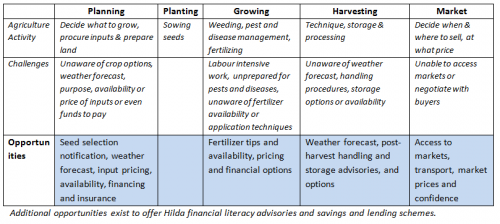This is the second of a 3 part blog series (read part 1 here) on a design workshop I participated in hosted by Mercy Corps Agri-Fin and facilitated by ThoughtWorks. Our objective was to brainstorm viable options for a mobile agriculture service targeting rural farmers in a Sub Saharan African country. Although this is an early stage commercial endeavour and most of the workshop activities are confidential, the following post has been cleared to share with our readers.
In the first blog post we introduced Hilda and described the first two stages of the workshop’s User Journey Approach (Defining Personas and Drafting a User’s Journey) which resulted in the identification of a few specific opportunities to develop a service for her. In today’s post, we’ll walk through the process of shaping product or service concepts around these opportunities, develop story boards to better describe the concept and explore possible business models and cases for investment.
Product/Service Concept
Working with the opportunities listed in the chart from Part 1, we can begin to draft service concepts for Hilda.
A logical category to organize the opportunities would be information-based service and a financial-based service. Because these opportunities are complimentary (some might say dependent on each other), one might consider the increasingly popular concept of bundled information advisory and financial services. This is a particularly compelling concept in markets with mobile money.
Storyboards
Our next step is to develop a comic book style story board (see image) which walks the reader through how the product or service is experienced from the user’s perspective. This is where most of the concepts become more tangible and are given greater definition. It’s important here to focus on the user’s experience and how the experience relates back to the Farmer Journey. At this stage, be careful not to get distracted or too concerned about how the service works “behind the scenes”.
Business Model
Finally, the design process for a commercial service wouldn’t be complete without an underlying business model outlining the financial viability and business case justifying investment. Business models define how a business will create, deliver and capture value. A useful tool here is the business model canvas from the popular book Business Model Generation. The canvas is organized into drivers of costs and revenues and helps to outlines key components of any business model.
Final Notes
This Farmer Journey is quite broad and only covers a single growing season and a single persona, Hilda. Additional journeys can be drafted to map out services in other areas (sourcing of inputs, selling of produce, paying school fees, livestock, etc.). It is also worth noting the purpose of this blog post is to simply introduce the topic and raise the awareness of this approach. Executing this requires careful planning. The use of a design agency or consultancy (ThoughtWorks, IDEO, Frog Design, etc.) to facilitate is highly recommended.
In the final post of our 3 part series, we’ll invite a guest blogger from ThoughtWorks to share additional insights and touch on why this approach is important and worth investing in.


